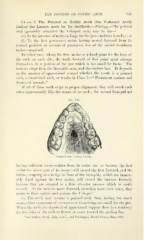Page 759 - My FlipBook
P. 759
—
THE POINTED OR GOTHIC ARCH. — 757
Class 8. The Pointed or Gothic Arch (the V-shaped Arch)
(called the Lancet Arch by Dr. Guilford). Etiology.—The pointed
arch (generally miscalled the V-shaped arch) may be due
(«) To the presence of teeth too large for the jaw—indirect heredity; or
(6) To the first permanent molar having moved forward from its
normal position on account of premature loss of the second deciduous
molar—acquired.
In either case, taking the first molar as a fixed point for the base of
the arch on each side, the teeth forward of that point must arrange
themselves in a portion of the jaw which is too small for them. The
incisors erupt first, the bicuspids next, and the canines last. It depends
on the manner of approximal contact whether the result is a pointed
—
arch, a constricted arch, or results in Class 7 " Prominent canines and
depressed laterals."
If all of these teeth erupt in proper alignment, they will touch each
other approximally like the stones of an arch ; the second bicuspid not
Fig. 747.
Pointed arch (V s,h ipi d irch)
having sufficient room—either from its extra size or because the first
molar has taken part of its room—will crowd the first forward, and the
canine, erupting as a Avedge in front of the bicuspids, which are immov-
ably fixed against the first molar, will crowd the incisors forward,
because they are situated in a thin alveolar -process which is easily
moved. As the incisors move forward, crowding upon each other, they
rotate in their sockets and assume the V siiape.^
(c) The teeth may assume a pointed arch from having too much
room, either on accoinit of extraction or from being too small for the jaw.
When the teeth are (lei)rived of approximal support there is a tendency
for the sides of the arch to flatten or move toward the median line.
' See Talbot, 3cl ed., chap, xxxii., and Ottolengiii, Dental Coi^mos, June 1892.
THE POINTED OR GOTHIC ARCH. — 757
Class 8. The Pointed or Gothic Arch (the V-shaped Arch)
(called the Lancet Arch by Dr. Guilford). Etiology.—The pointed
arch (generally miscalled the V-shaped arch) may be due
(«) To the presence of teeth too large for the jaw—indirect heredity; or
(6) To the first permanent molar having moved forward from its
normal position on account of premature loss of the second deciduous
molar—acquired.
In either case, taking the first molar as a fixed point for the base of
the arch on each side, the teeth forward of that point must arrange
themselves in a portion of the jaw which is too small for them. The
incisors erupt first, the bicuspids next, and the canines last. It depends
on the manner of approximal contact whether the result is a pointed
—
arch, a constricted arch, or results in Class 7 " Prominent canines and
depressed laterals."
If all of these teeth erupt in proper alignment, they will touch each
other approximally like the stones of an arch ; the second bicuspid not
Fig. 747.
Pointed arch (V s,h ipi d irch)
having sufficient room—either from its extra size or because the first
molar has taken part of its room—will crowd the first forward, and the
canine, erupting as a Avedge in front of the bicuspids, which are immov-
ably fixed against the first molar, will crowd the incisors forward,
because they are situated in a thin alveolar -process which is easily
moved. As the incisors move forward, crowding upon each other, they
rotate in their sockets and assume the V siiape.^
(c) The teeth may assume a pointed arch from having too much
room, either on accoinit of extraction or from being too small for the jaw.
When the teeth are (lei)rived of approximal support there is a tendency
for the sides of the arch to flatten or move toward the median line.
' See Talbot, 3cl ed., chap, xxxii., and Ottolengiii, Dental Coi^mos, June 1892.


